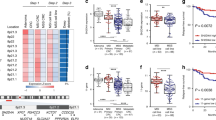Abstract
Small ArfGAP1 (stromal membrane-associated protein 1, SMAP1), a GTPase-activating protein specific for ADP-ribosylation factor 6 (Arf6), which is a small GTPase acting on membrane trafficking and actin remodeling, is frequently mutated in various tumors displaying microsatellite instability (MSI), notably in MSI colorectal cancers (CRC). Genotyping of 93 MSI CRCs (40 stage II, 32 stage III and 21 stage IV) allowed us to underscore that SMAP1 mutation frequency was inversely correlated with disease stage (P=0.01). Analysis of 46 cancer cell lines showed that SMAP1 mutations occurred only in MSI tumors, and consisted exclusively in short insertion or deletion in the coding 10-adenine repeat, generating a premature termination codon located downstream the ArfGAP domain. SMAP1 transcript levels were significant decreased (P=0.006), and truncated SMAP1 protein could not be detected in cells displaying biallelic SMAP1 mutations, owing to its sensitivity to proteasome degradation. To investigate the role of SMAP1 mutations, we used the SMAP1-null HCT116 cell line and we established three isogenic SMAP1-complemented clones. Cell proliferation was first assessed in vivo using subcutaneous xenografts into immunodeficient mice. Tumors developed in all animals regardless of the cell line injected, but tumor volumes were significantly smaller for both SMAP1-complemented clones compared with HCT116 (P<0.0001, at the time of killing). In vitro, SMAP1 mutations also increased cell clonogenicity (P=0.02–0.04), cell proliferation (P=0.008) by shortening the G2/M phase and decreased cell invasiveness (P=0.03–0.003). In keeping, SMAP1-complemented HCT116 gained several mesenchymal markers (Snail, Slug and vimentin) considered as a hallmark of epithelial-to-mesenchymal transition. These observations are reminiscent of some clinical characteristics of MSI CRCs, notably their larger size and lower rate of metastasis. Our observations suggest that SMAP1 loss-of-function mutations in MSI CRC may contribute to the emerging oncogenic pathway involving abnormal Arf6 regulation.
This is a preview of subscription content, access via your institution
Access options
Subscribe to this journal
Receive 50 print issues and online access
$259.00 per year
only $5.18 per issue
Buy this article
- Purchase on Springer Link
- Instant access to full article PDF
Prices may be subject to local taxes which are calculated during checkout





Similar content being viewed by others
References
Peltomaki P . Lynch syndrome genes. Fam Cancer 2005; 4: 227–232.
Zaanan A, Meunier K, Sangar F, Flejou JF, Praz F . Microsatellite instability in colorectal cancer: from molecular oncogenic mechanisms to clinical implications. Cell Oncol (Dordr) 2011; 34: 155–176.
Duval A, Hamelin R . Mutations at coding repeat sequences in mismatch repair-deficient human cancers: toward a new concept of target genes for instability. Cancer Res 2002; 62: 2447–2454.
Woerner SM, Yuan YP, Benner A, Korff S, von Knebel Doeberitz M, Bork P . SelTarbase, a database of human mononucleotide-microsatellite mutations and their potential impact to tumorigenesis and immunology. Nucleic Acids Res 2010; 38: D682–D689.
Loire E, Praz F, Higuet D, Netter P, Achaz G . Hypermutability of genes in Homo sapiens due to the hosting of long mono-SSR. Mol Biol Evol 2009; 26: 111–121.
Isken O, Maquat LE . Quality control of eukaryotic mRNA: safeguarding cells from abnormal mRNA function. Genes Dev 2007; 21: 1833–1856.
El-Bchiri J, Guilloux A, Dartigues P, Loire E, Mercier D, Buhard O et al. Nonsense-mediated mRNA decay impacts MSI-driven carcinogenesis and anti-tumor immunity in colorectal cancers. PLoS One 2008; 3: e2583.
Marcos I, Borrego S, Rodriguez de Cordoba S, Galan JJ, Antinolo G . Cloning, characterization and chromosome mapping of the human SMAP1 gene. Gene 2002; 292: 167–171.
Tanabe K, Kon S, Natsume W, Torii T, Watanabe T, Satake M . Involvement of a novel ADP-ribosylation factor GTPase-activating protein, SMAP, in membrane trafficking: implications in cancer cell biology. Cancer Sci 2006; 97: 801–806.
Tanabe K, Torii T, Natsume W, Braesch-Andersen S, Watanabe T, Satake M . A novel GTPase-activating protein for ARF6 directly interacts with clathrin and regulates clathrin-dependent endocytosis. Mol Biol Cell 2005; 16: 1617–1628.
Kon S, Tanabe K, Watanabe T, Sabe H, Satake M . Clathrin dependent endocytosis of E-cadherin is regulated by the Arf6GAP isoform SMAP1. Exp Cell Res 2008; 314: 1415–1428.
Natsume W, Tanabe K, Kon S, Yoshida N, Watanabe T, Torii T et al. SMAP2, a novel ARF GTPase-activating protein, interacts with clathrin and clathrin assembly protein and functions on the AP-1-positive early endosome/trans-Golgi network. Mol Biol Cell 2006; 17: 2592–2603.
D'Souza-Schorey C, Chavrier P . ARF proteins: roles in membrane traffic and beyond. Nat Rev Mol Cell Biol 2006; 7: 347–358.
Palacios F, Price L, Schweitzer J, Collard JG, D'Souza-Schorey C . An essential role for ARF6-regulated membrane traffic in adherens junction turnover and epithelial cell migration. Embo J 2001; 20: 4973–4986.
Hashimoto S, Onodera Y, Hashimoto A, Tanaka M, Hamaguchi M, Yamada A et al. Requirement for Arf6 in breast cancer invasive activities. Proc Natl Acad Sci USA 2004; 101: 6647–6652.
Muralidharan-Chari V, Hoover H, Clancy J, Schweitzer J, Suckow MA, Schroeder V et al. ADP-ribosylation factor 6 regulates tumorigenic and invasive properties in vivo. Cancer Res 2009; 69: 2201–2209.
Wang J, Sun L, Myeroff L, Wang X, Gentry LE, Yang J et al. Demonstration that mutation of the type II transforming growth factor beta receptor inactivates its tumor suppressor activity in replication error-positive colon carcinoma cells. J Biol Chem 1995; 270: 22044–22049.
Hempen PM, Zhang L, Bansal RK, Iacobuzio-Donahue CA, Murphy KM, Maitra A et al. Evidence of selection for clones having genetic inactivation of the activin A type II receptor (ACVR2) gene in gastrointestinal cancers. Cancer Res 2003; 63: 994–999.
Gardner LB, Nonsense-mediated RNA . decay regulation by cellular stress: implications for tumorigenesis. Mol Cancer Res 2010; 8: 295–308.
Montagnac G, Sibarita JB, Loubery S, Daviet L, Romao M, Raposo G et al. ARF6 interacts with JIP4 to control a motor switch mechanism regulating endosome traffic in cytokinesis. Curr Biol 2009; 19: 184–195.
Sabe H . Requirement for Arf6 in cell adhesion, migration, and cancer cell invasion. J Biochem 2003; 134: 485–489.
Miquel C, Jacob S, Grandjouan S, Aime A, Viguier J, Sabourin JC et al. Frequent alteration of DNA damage signalling and repair pathways in human colorectal cancers with microsatellite instability. Oncogene 2007; 26: 5919–5926.
Claperon A, Guedj N, Mergey M, Vignjevic D, Desbois-Mouthon C, Boissan M et al. Loss of EBP50 stimulates EGFR activity to induce EMT phenotypic features in biliary cancer cells. Oncogene 2012; 31: 1376–1388.
Acknowledgements
We thank Drs Mathieu Boissan, Philippe Chavrier, Marie-Lise Lacombe and Guillaume Montagnac for their constant support and helpful discussions, as well as Dr Peggy Cuilliere-Dartigues for sharing some data. We are grateful to Martine Mergey, Anne-Marie Faussat and Philippe Fontanges for their invaluable help in RT-PCRq analyses, cytometry and confocal microscopy, respectively. We further acknowledge the expert technical assistance of Fatiha Mérabtene in performing immunohistochemical analyses of mouse and human tumor samples. We are indebted to the members of INSERM UMR_S 903 for sharing the ImageJ plugin. Fatiha Sangar received a 3-year fellowship from ‘Ministère de l’Enseignement Supérieur et de la Recherche’ followed by a 6-month funding from ‘Fondation ARC pour la Recherche sur le Cancer’. This work has been supported by grants from the Association pour la Recherche sur le Cancer (#5091) and from the Ligue Nationale Contre le Cancer (RS10/75-72 and RS11/75-89).
Author information
Authors and Affiliations
Corresponding author
Ethics declarations
Competing interests
The authors declare no conflict of interest.
Additional information
Supplementary Information accompanies this paper on the Oncogene website
Rights and permissions
About this article
Cite this article
Sangar, F., Schreurs, AS., Umaña-Diaz, C. et al. Involvement of small ArfGAP1 (SMAP1), a novel Arf6-specific GTPase-activating protein, in microsatellite instability oncogenesis. Oncogene 33, 2758–2767 (2014). https://doi.org/10.1038/onc.2013.211
Received:
Revised:
Accepted:
Published:
Issue Date:
DOI: https://doi.org/10.1038/onc.2013.211



